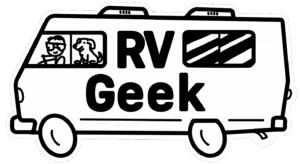
RV Black Tanks: The Throne Zone You Can’t Ignore! Number Two!
Dumping your RV’s tanks is a rite of passage for every camper. I call it the glamorous side of camping. With a grin and a few chuckles along the way. Here’s a step-by-step guide to empty your black and gray water tanks at a dump station. I was very squamish about this when I started – I don’t even give it a seconds thought any more. Done right – its simple!
Step 1: Pull Up to the Dump Station with Confidence
- What to Do: Approach the dump station, stopping with the dump valves close to the dump station inlet. Leave enough room to access your hoses and valves without feeling cramped. You’re about to give this station the “business”—make sure you’re positioned to deliver the goods!
- Pro Tip: Check for a line of RVs waiting their turn, if it is long you can eliminate some steps, save them for full hookup sites or when there is no line. Nobody likes a dump station hog, so be ready to move efficiently.
Step 2: Gear Up Like a Poop-Handling Pro
- What to Do: Put on disposable gloves (not reusable ones) to keep your hands clean. Grab your sewer hose from its storage location, usually they fit inside the tube that is your bumper.
- Pro Tip: Keep a dedicated pair of “dump shoes” to avoid tracking any “mystery splashes” back into your RV. Also, its not uncommon for the square end plugs to come off while driving, keep an extra set on hand just in case.
Step 3: Connect the Sewer Hose with Care
- What to Do: Attach one end of the sewer hose to your RV’s black water tank valve outlet, and secure the other end to the dump station’s inlet. You will want a 4 in one adapter commonly called a ‘donut’. This will ensure an odor free seal. This is a legal requirement in some places.
- Pro Tip: Double-check both connections. A loose hose can lead to a “brownout” you’ll never forget.
Step 4: The moment of truth!
- What to Do: Ensure the gray water valve is closed. Pull the black water valve (usually the black T-handle) to release the contents. Do this quickly. You want to hear a satisfying whoosh as the tank empties. Once it is at a trickle close the blade valve.
- Pro Tip: On days with busy lines, have someone inside the camper fill and flush the toilet several times, each time filling to nearly the top, ease up to this as you gain experience to ensure you have no unexpected splashing. You should fill the tank about 15-20% full. Then, add the treatment. Wait to do the full tank flush when there is no line.
Step 5: Rinse the Black Tank
- What to Do: Close the black water valve once the tank is empty. If there is no line, or you are at full hookups now is the time to flush your tank. Look for the black tank rinse (you may not have one) and connect a garden hose (NOT your drink water hose) to it and run clean water through the tank for 1-2 minutes. If your coach does not have one you can simply do the flush technique above, and drain the tank a couple of times.
- Pro Tip: Never leave the flush hose unattended! Water has three ways out of the tank. The dump valve, which you have closed, the toilet (which should be sealed), and the roof vent. Left unattended, you will be allowed to deep clean the floor in your camper or your roof. Never leave that hose unattended or running for more than a few minutes.
Checkpoint
- Your black tank should be emptied, optionally rinsed, and the black tank valve closed.
- Roughly 15-20% of the tank has been refilled with water (you’re looking for an inch or two in the tank to prevent “pyramids”) and a shot of treatment should be added.
Step 6: Empty the Gray Tank
- What to Do: Open the gray water valve to empty the shower and sink water, just as you did the black tank. The T-Handle us usually grey. Emptying grey tanks last will rinse the sewer hose and dump station inlet.
- Pro Tip: Your RV may have two grey tanks. Sometimes, they have completely isolated ports, other times you just have two grey valves to open. See your manufacturer documentation or ask your dealer.
Step 7: Disconnect and Clean the Hose
- What to Do: Close all valves tightly, and replace the cap. Disconnect the sewer hose from the RV first, then rinse it out. The dump station usually has a spigot there for that purpose.
- Pro Tip: If you do not have a dedicated storage location like your bumper, and there is no spigot nearby, join the two ends of the hose together until you can rinse them out.
Step 8: Sanitize the Area and Your Hands
- What to Do: Use the dump station’s rinse hose to clean any spills around the inlet. Dispose of gloves in a trash bin (never flush them). Wash your hands with soap and water or use hand sanitizer.
Step 9: Pack Up and Double-Check
- What to Do: Stow all equipment securely. Ensure your RV’s valves are closed and caps are back on the sewer outlet. Check that you’ve left the dump station clean for the next camper.
Step 10: Drive Away with Pride
- What to Do: Pull away from the dump station carefully, waving to any waiting RVers like the seasoned pro you are. Head to your next adventure with a lighter RV and a sense of accomplishment!
Final Notes
- Safety First: Always wear gloves and avoid direct contact with waste. If a spill occurs, clean it promptly to keep the station usable for others. There is nothing more disguising than having to clean up some one elses mess.
- Eco Tip: Use RV-safe tank treatments to break down waste and reduce odors. I like probiotic/enzymatic that do not use fragrances such as TankTechRX or Liquified RV Toilet Treatment, though Liquified does use fragrance it is still very good. The packets you can buy in the camping aisle good in an emergency, but I very much prefer the brands I mentioned above.
Congratulations! You’ve just earned the bragging rights for dumping your tank! Done correclty, this should take no more than 5-7 minutes to do. If there is a line forgo the deep cleaning of the black tank – you can do that some other time. It is not necessary to do that every time IF you use enough water when flushing, and if you keep the tank partially filled before use.
As always if you have any questions about this do not hesitate us! We’re here to help.
As always if you have any questions about this do not hesitate us! We’re here to help.
Stay Where You Are, We’ll Be Right There
As with all of our work, our team will come to you. There is no need to transport your camper or RV to a facility, leave it for days or weeks, only to have to go pick it up again. Whether it is in your driveway, a camp-site, or in storage, we will do our best to accommodate your needs, schedule, and location.
Just contact us, and we’ll take care of the rest.

